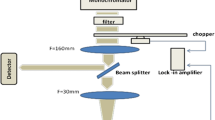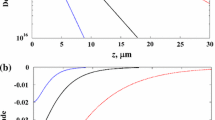Abstract
The steady-state photocarrier grating (SSPG) technique has been employed to investigate the field dependence of different polymorphous and microcrystalline silicon samples prepared by plasma enhanced chemical vapor deposition technique. The field-dependent experimental data at different temperatures are analyzed using two different approaches based on the small-signal photocurrent to extract more information on the electronic properties (like small signal mobility life time product, average drift length for holes and electrons,... etc.). The quality of the fits is tested by the χ2 indicator and the best choice of the transport parameters is obtained in each approach. The values of electron and hole drift mobilities obtained from one approach are compared to those found by others. The trapped charge density can be determined, for all samples, and correlated to minority-carrier diffusion length. It is also found that the decrease in temperature in a microcrystalline sample may result in an increase of the trapped charge density. This increase in trapped carrier density may be consistent with the increase in sub-gap absorption. Such behavior is found in agreement with that reported in the literature. In addition, the polymorphous samples that have values of diffusion lengths comparable to those of microcrystalline samples exhibit higher values of trapped carrier density.



Similar content being viewed by others
References
D. Ritter, E. Zeldov, K. Weiser, Appl. Phy. Lett. 49, 791 (1986)
D. Ritter, K. Weiser, E. Zeldov, J. Appl. Phys. 62, 4563 (1987)
D. Ritter, K. Weiser, E. Zeldov, Phys. Rev. B 38, 8296 (1988)
Y.M. Li, Phys. Rev. B 42, 9025 (1990)
K. Hattori, H. Okamoto, Y. Hamakawa, Phys. Rev. B 45, 1126 (1992)
C.D. Abel, G.H. Bauer, W.H. Bloss, Phil.l Mag. B 72, 51 (1995)
J.A. Schmidt, C. Longeaud, Appl. Phys. Lett. 85, 4412 (2004)
J.A. Schmidt, C. Longeaud, Phys. Rev. B 71, 125208 (2005)
R. Brueggemann, R.I. Badran, Mat. Res. Soc. Symp., vol 808, A9.7.1 (San Francisco-USA, 2004)
H. Brummack, R. Brüggemann, H. N. Wanka, A. Hierzenberger, M.B. Schubert, Proc. 26th IEEE Photovoltaic Specialists Conf. (IEEE, Piscataway, 1997), p. 679
R.S. Brueggemann, O. Kunz, Phys. Status Solidi B 234, R16 (2002)
C. Longeaud, J.P. Kleider, M. Gauthier, R. Bruggemann, Y. Poissant, P. Roca, I. Cabarrocas, Mat. Res. Soc. Symp. (San Francisco-USA, 5–9 April 1999), pp. 501–506
R. Brueggemann, J. Mat. Sci: Mater. Electron. 14, 629 (2003)
J.P. Kleider, M. Gauthier, C. Longeaud, D. Roy, O. Saadane, R. Brueggemann, Thin Solid films 403–404, 188 (2002)
T. Dylla, F. Finger, E.A. Schiff, Appl. Phys. Lett. 87, 0321103 (2005)
L.C. Cheng, S. Wagner, Appl. Phys. Lett. 80, 440 (2002)
J.P. Kleider, C. Longeaud, M. Gauthier, M. Meaudre, R. Meaudre, R. Butte, S. Vignoli, P. Roca I Cabarrocas, Appl. Phys. Lett 75, 3351 (1999)
S. Reynolds, V. Smirnov, F. Finger, C. Main, R. Carius, J. Optoelect. Adv. Mat. 7, 91 (2005)
R. Brueggemann, J.P. Kleider, C. Longeaud, in Proceedings of the 16th European Photovoltaic Solar Energy Conference, vol 1.62 (Glasgow, UK, VB, 2000), p. 1/4
R.I. Badran, N.N. Al-Awwad, J. Optoelectron. Adv. Mat. 8, 1466 (2006).
Acknowledgments
The author is grateful to the Higher Council of Science and Technology (HCST), Jordan and the Deutsche Forschungsgemeinschaft (DFG), Bonn, Germany for their support. He is also grateful to Dr Rudi Brueggemann at Oldenburg University-Germany, and to H. Brummack and K. Bruhne, institute fur Physikalische Elektronik, Universitat Stuttgart, for providing the experimental data and providing the samples. I would like to thank Prof H. Ghassib for his proof reading of the final draft of this paper.
Author information
Authors and Affiliations
Corresponding author
Appendix A
Appendix A
In order to fit the field dependence experimental data of β, due to Li approach [4], an expression for the coefficient β is derived using the equation [1]:
where ΔJ = J(I 1, I 2) − J(I 1 + I 2). The current density of pure bias illumination J(I 1 + I 2) can be written as:
Assuming a power law intensity dependence of current density J(I) of the form J(I)≈ (I)γ, J(I 1) can be obtained from Eq. (A.2) and written as:
Substitute Eqs. (1), (A.2) and (A.3) into Eq. (A.1) and after simple rearrangements we get:
This general formula for coefficient β is expressed in terms of eight parameters. In addition to the parameters of \(l\left({=\frac{2\pi L_{\rm amb}}{\Lambda}}\right)\), a(= τ/τdiel), b(= μ n /μ p ), \(d\left({=\frac{2\pi\sqrt{\mu_n \mu_p \tau}E_0}{\Lambda}}\right)\), g 1/N 0 and τ which already exist in the original formula of ΔJ [4], two parameters of I 2/I 1 and, γ are introduced in the newly developed formula of β (Eq. (A.4)).
Rights and permissions
About this article
Cite this article
Badran, R.I. Analysis of field dependent steady-state photocarrier grating measurements on polymorphous and microcrystalline silicon films. J Mater Sci: Mater Electron 18, 405–414 (2007). https://doi.org/10.1007/s10854-006-9047-x
Received:
Accepted:
Published:
Issue Date:
DOI: https://doi.org/10.1007/s10854-006-9047-x




